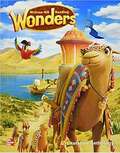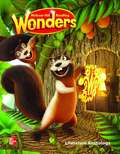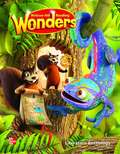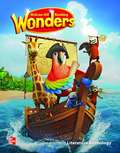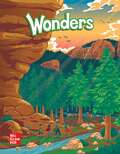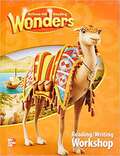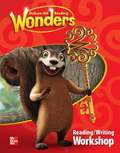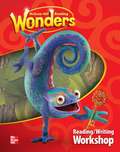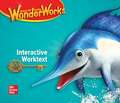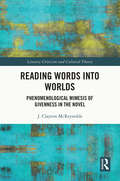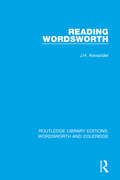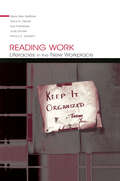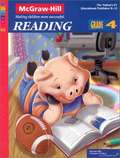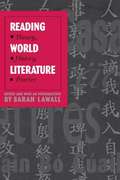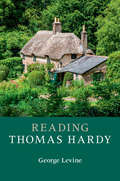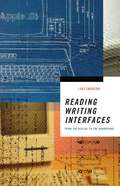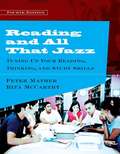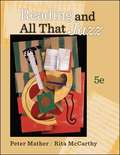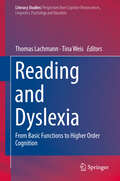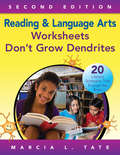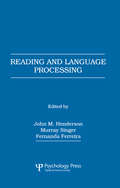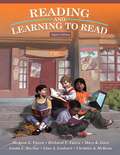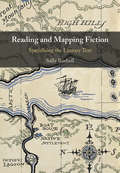- Table View
- List View
Reading Wonders Literature Anthology Grade 3 (Elementary Core Reading Ser.)
by McGraw HillReading Wonders Literature Anthology Grade 3 provides text for students to practice and apply close reading and writing to sources. The Literature Anthology includes many exemplars and award-winning texts.
Reading Wonders Literature Anthology Volume 1 Grade 1 (Elementary Core Reading Ser.)
by McGraw HillBursting with stories and informational text selections by award-winning authors and illustrators, the Wonders Literature Anthology lets students apply strategies and skills from the Reading/Writing Workshop to extended complex text. *This textbook has been transcribed in UEB, formatted according to Braille textbook formats, proofread and corrected.
Reading Wonders Literature Anthology Volume 2 Grade 1 (Elementary Core Reading Ser.)
by McGraw HillBursting with stories and informational text selections by award-winning authors and illustrators, the Wonders Literature Anthology lets students apply strategies and skills from the Reading/Writing Workshop to extended complex text. *This textbook has been transcribed in UEB, formatted according to Braille textbook formats, proofread and corrected.
Reading Wonders Literature Anthology Volume 4 Grade 1 (Elementary Core Reading Ser.)
by McGraw HillBursting with stories and informational text selections by award-winning authors and illustrators, the Wonders Literature Anthology lets students apply strategies and skills from the Reading/Writing Workshop to extended complex text. *This textbook has been transcribed in UEB, formatted according to Braille textbook formats, proofread and corrected.
Reading Wonders Literature Anthology: Grade 4
by McGraw-Hill EducationReading Wonders Grade 4 Literature Anthology
Reading Wonders Reading/Writing Workshop: Grade 3 (Elementary Core Reading Series)
by McGraw HillConcise and focused, the Wonders Reading/Writing Workshop is a powerful instructional tool that provides students with systematic support for the close reading of complex text. Introduce the week’s concept with video, photograph, interactive graphic organizers, and more Teach through mini lessons that reinforce comprehension strategies and skills, genre, and vocabulary Model elements of close reading with shared, short-text reads of high interest and grade-level rigor
Reading Wonders Reading/writing Workshop Volume 1 Grade 1 (Elementary Core Reading Ser.)
by McGraw HillBursting with stories and informational text selections by award-winning authors and illustrators, the Wonders Literature Anthology lets students apply strategies and skills from the Reading/Writing Workshop to extended complex text. *This textbook has been transcribed in UEB, formatted according to Braille textbook formats, proofread and corrected.
Reading Wonders Reading/writing Workshop Volume 2 Grade 1 (Elementary Core Reading Ser.)
by McGraw HillBursting with stories and informational text selections by award-winning authors and illustrators, the Wonders Literature Anthology lets students apply strategies and skills from the Reading/Writing Workshop to extended complex text. *This textbook has been transcribed in UEB, formatted according to Braille textbook formats, proofread and corrected.
Reading Wonders Reading/writing Workshop Volume 3 Grade 1 (Elementary Core Reading Ser.)
by McGraw HillBursting with stories and informational text selections by award-winning authors and illustrators, the Wonders Literature Anthology lets students apply strategies and skills from the Reading/Writing Workshop to extended complex text. *This textbook has been transcribed in UEB, formatted according to Braille textbook formats, proofread and corrected.
Reading Wonderworks Interactive Worktext Grade 2 (Reading Intervention)
by Douglas Fisher Timothy Shanahan Jan HasbrouckThe Interactive Worktext for grades 2-6 is a scaffolded version of the Reading Wonders Reading/Writing Workshop. It allows students to interact with complex texts through close reading by taking notes, marking text evidence, and writing responses in their own print or eBook version.
Reading Wonderworks Interactive Worktext [Grade 6], Reading/Writing Workshop
by McGraw-HillThe Interactive Worktext for grades 2-6 is a scaffolded version of the Reading Wonders Reading/Writing Workshop. It allows students to interact with complex texts through close reading by taking notes, marking text evidence, and writing responses in their own print or eBook version.
Reading Words into Worlds: Phenomenological Mimesis of Givenness in the Novel (Literary Criticism and Cultural Theory)
by J. Clayton McReynoldsReading Words into Worlds asks how it is that reading a novel can feel in some ways like being-in-a-world. The book explores how novels give themselves to readers in ways that mimetically resemble our phenomenological reception of given beings in reality. McReynolds refers to this process as phenomenological mimesis of givenness, and he draws on the phenomenological philosophy of Husserl, Heidegger, and Jean-Luc Marion to explore how masterful novels can make reading ink marks on a page feel like seeing things, feeling things, and meeting (even loving) others. McReynolds blends rigorous phenomenological study with a personable style, first laying out his theory in detail and then applying that theory through close studies of his reading experiences of four British realist masterpieces: Defoe’s Robinson Crusoe, Austen’s Northanger Abbey, Eliot’s Middlemarch, and Hardy’s Jude the Obscure. Ultimately, this book offers a grounded phenomenology of novel-reading, illuminating what gives novels such power to not only thrill readers—but to change them.
Reading Wordsworth (RLE: Wordsworth and Coleridge #1)
by J.H. AlexanderFirst published in 1987, this book is written for those who are encountering Wordsworth for the first time and for those familiar with his works that are at a loss to understand his reputation or why his work has impressed them. The strength of the author’s approach is that it unravels the poet’s true meaning and the process by which he all too frequently lost the voice of inspiration — working and reshaping his poems until the original freshness disappeared. It concentrates on helping the reader appreciate Wordsworth’s distinctive and daring way with words and poetic structure. By showing Wordsworth’s failures, the author demonstrates by contrast the achievements of his greatest works.
Reading Work: Literacies in the New Workplace
by Nancy S. Jackson Mary Ellen Belfiore Tracy A. Defoe Sue Folinsbee Judy HunterReading Work: Literacies in the New Workplace explores changing understandings of literacy and its place in contemporary workplace settings. It points to new questions and dilemmas to consider in planning and teaching workplace education. By taking a social perspective on literacies in the workplace, this book challenges traditional thinking about workplace literacy as functional skills, and enables readers to see the complexity of literacy practices and their embeddedness in culture, knowledge, and action. A mixture of ethnographic studies, analysis, and personal reflections makes these ideas accessible and relevant to a wide range of readers in the fields of adult literacy and language education and helps to bridge the divide between theory and practice in the field of workplace education.Reading Work: Literacies in the New Workplace features: *four distinct but related ethnographies of literacy use in contemporary workplaces;*a social practice view of literacy brought to the workplace;*collaborative research undertaken by experienced workplace educators and academics working in the areas of adult literacy and second language learning;*implications chapters for both practice and theory--presented not as a series of steps but rather as reflections by seasoned educators on shared dilemmas; and*engaging, accessible writing that encourages workplace practitioners to read, learn from, and do their own research.This book is an important resource for practicing workplace educators, trainers, and instructors; academics who teach workplace educators; unionists, policymakers, human resource managers, supervisors, or quality coordinators who believe education can make a difference and are interested in seeing maximum results from workplace learning. Visit the In-Sites Research Group Web site: http://www.nald.ca/insites/.
Reading Workbook (Grade #4)
by SpectrumSpectrum Reading grade 4 has engaging, lively passages in curriculum content areas. Recently updated to current national reading standards, including more nonfiction reading passages and activities. This book for children ages 9 to 10 contains proven instructional methods for developing reading proficiency. Reading skills include: ~Cause and effect ~Character analysis ~Reading comprehension ~Context practice ~Research skills Our best-selling Spectrum Reading series features grade-appropriate books for Preschool to 6. Developed with the latest standards-based teaching methods that provide targeted practice in reading fundamentals to ensure successful learning.
Reading World Literature: Theory, History, Practice
by Sarah LawallAs teachers and readers expand the canon of world literature to include writers whose voices traditionally have been silenced by the dominant culture, fundamental questions arise. What do we mean by "world"? What constitutes "literature"? Who should decide? <P><P> Reading World Literature is a cumulative study of the concept and evolving practices of "world literature." Sarah Lawall opens the book with a substantial introduction to the overall topic. Twelve original essays by distinguished specialists run the gamut from close readings of specific texts to problems of translation theory and reader response. The sequence of essays develops from re-examinations of traditional canonical pieces through explorations of less familiar works to discussions of reading itself as a "literacy" dependent on worldview. <P> Reading World Literature will open challenging new vistas for a wide audience in the humanities, from traditionalists to avant-garde specialists in literary theory, cultural studies, and area studies.
Reading Writers and Their Work: Reading Thomas Hardy (Reading Writers and their Work)
by George LevineThis major new reading of the novels of Thomas Hardy, by leading critic George Levine, disentangles the author's often elaborately distanced prose from his beautiful poetic and precise renderings of the natural world. Clear, direct and minimally academic in his own writing, Levine provides an overview of Hardy's entire fictional canon, with extensive discussions of his early and late novels including his last, The Well-Beloved. Levine draws new attention to the way Hardy absorbed both the ideas and the writing strategies of Charles Darwin, and develops new perspectives first articulated in the criticism of great novelists - in particular Virginia Woolf and D. H. Lawrence. Levine departs from the critical norm by reading Hardy in the context of his deep feeling for the natural world and all living things, and the implicit affirmation of life that sometimes drives his bleakest narratives.
Reading Writing Interfaces: From the Digital to the Bookbound (Electronic Mediations #44)
by Lori EmersonLori Emerson examines how interfaces—from today&’s multitouch devices to yesterday&’s desktops, from typewriters to Emily Dickinson&’s self-bound fascicle volumes—mediate between writer and text as well as between writer and reader. Following the threads of experimental writing from the present into the past, she shows how writers have long tested and transgressed technological boundaries.Reading the means of production as well as the creative works they produce, Emerson demonstrates that technologies are more than mere tools and that the interface is not a neutral border between writer and machine but is in fact a collaborative creative space. Reading Writing Interfaces begins with digital literature&’s defiance of the alleged invisibility of ubiquitous computing and multitouch in the early twenty-first century and then looks back at the ideology of the user-friendly graphical user interface that emerged along with the Apple Macintosh computer of the 1980s. She considers poetic experiments with and against the strictures of the typewriter in the 1960s and 1970s and takes a fresh look at Emily Dickinson&’s self-printing projects as a challenge to the coherence of the book.Through archival research, Emerson offers examples of how literary engagements with screen-based and print-based technologies have transformed reading and writing. She reveals the ways in which writers—from Emily Dickinson to Jason Nelson and Judd Morrissey—work with and against media interfaces to undermine the assumed transparency of conventional literary practice.
Reading and All That Jazz (4th Edition)
by Peter Mather Rita MccarthyThis attractive, engaging introductory-to-intermediate reading text for undergraduates begins by introducing students to study skills and the college environment, with readings on learning styles, different types of intelligence, stress, and other areas that help students understand themselves as learners. The text then broadens the perspective to focus on interpersonal, social, national, and international issues, within sections on discovering meaning through structure, interpreting written material, recognizing modes of writing, reading critically, and getting ready for content-area classes.
Reading and All That Jazz (5th Edition)
by Peter Mather Rita MccarthyReading and All That Jazz, an introductory-to-intermediate reading text, motivates and engages readers with contemporary and relevant readings while building the essential reading skills and vocabulary needed for literal and critical comprehension. With multiple practice opportunities and an adaptive learning plan via Connect Reading, Reading and All That Jazz provides for genuine thinking, assessment, and interpretation.
Reading and Dyslexia: From Basic Functions To Higher Order Cognition (Literacy Studies #16)
by Thomas Lachmann Tina WeisIn this volume a group of well-known experts of the field cover topics ranging from basic visual and auditory information processing to higher order cognition in reading and dyslexia, from basic research to remediation approaches and from well-established theories to new hypotheses about reading acquisition and causes for its failure. Reading is one of the most intriguing feats human evolution ever came up with. There is no evolutionary basis for reading as such; reading is secondary to language and the result of a complex skill acquisition at the end of which almost all pre-existing cognitive functions are mobilized. With the right instruction and practice most people learn this skill smoothly. Some, however, have problems, despite same opportunities and general cognitive abilities. This developmental dyslexia results from a neuro developmental disorder leading to deficits in reading relevant information processing. But what deficits are these, and can they be trained?
Reading and Language Arts Worksheets Don't Grow Dendrites: 20 Literacy Strategies That Engage the Brain
by Marcia L. TateBrain-based strategies turn reluctant readers into motivated learners! Building on Marcia Tate’s successful “dendrite-growing” teaching strategies, Reading and Language Arts Worksheets Don’t Grow Dendrites contains 300 instructional activities and brain-compatible literacy. Newly consistent with Common Core State Standards, this resource offers hands-on techniques to help teach reading in relevant, motivating, and engaging ways. Activities cover literacy instruction including: Phonemic awareness Phonics and vocabulary instruction Text comprehension Reading authentically, widely, and strategically Writing strategically Creating, critiquing, and discussing texts Conducting research Using technological resources Respecting diversity in language Participating in literary communities Using language to accomplish purposes
Reading and Language Processing
by Fernanda Ferreira Murray Singer John M. HendersonThis volume was designed to identify the current limits of progress in the psychology of reading and language processing in an information processing framework. Leaders in their fields of interest, the chapter authors couple current theoretical analyses with new, formally presented experiments. The research -- cutting-edge and sometimes controversial -- reflects the prevailing analysis that language comprehension results in numerous levels of representation, including surface features, lexical properties, linguistic structures, and idea networks underlying a message as well as the situations to which a message refers. As a group, the chapters highlight the impact that input modality -- auditory or written -- has on comprehension. Finally, the studies also capture the evolution of new topic matter and ongoing debates concerning the competing paradigms, global proposals, and methods that form the foundation of the enterprise. The book presents current accounts of research on word-, sentence-, and text-processing. It will prove informative for experimental psychologists as well as investigators in cognitive science disciplines such as computer science, linguistics, and educational psychology. The book will also be very helpful to graduate students who wish to develop expertise in the psychology of language processes. For them, it collects, in a single volume, readings that are representative of progress concerning many central problems in the field. As such, it is distinct from the numerous collected volumes that concentrate on a single issue. Complete author and subject indexes facilitate effective use of the volume.
Reading and Learning to Read (8th Edition)
by Jo Anne L. Vacca Richard T. Vacca Mary K. Gove Linda C. Burkey Lisa A. Lenhart Christine A. MckeonReading and Learning to Read, 8/e is a highly-popular resource that expertly prepares pre-service and in-service teachers for today's ever-changing literacy classroom with its comprehensive coverage of philosophies, teaching strategies, and assessment practices. In addition, this book focuses on helping teachers implement effective research-based strategies with struggling and diverse learners; presents practical applications that engage students in new literacies and technology applications; and features the International Reading Association 2010 Standards for Reading Professionals. Professors, pre-service and in-service teachers will find this textbook user-friendly in format, design, and writing style; the expert knowledge is comprehensive and understandable.
Reading and Mapping Fiction: Spatialising the Literary Text
by Sally BushellDo we map as we read? How central to our experience of literature is the way in which we spatialise and visualise a fictional world? Reading and Mapping Fiction offers a fresh approach to the interpretation of literary space and place centred upon the emergence of a fictional map alongside the text in the late nineteenth and early twentieth centuries. Bringing together a range of new and emerging theories, including cognitive mapping and critical cartography, Bushell compellingly argues that this activity, whatever it is called – mapping, diagramming, visualising, spatialising – is a vital and intrinsic part of how we experience literature, and of what makes it so powerful. Drawing on both the theory and history of literature and cartography, this richly illustrated study opens up understanding of spatial meaning and interpretation in new ways that are relevant to both more traditional academic scholarship and to newly emerging digital practices.
